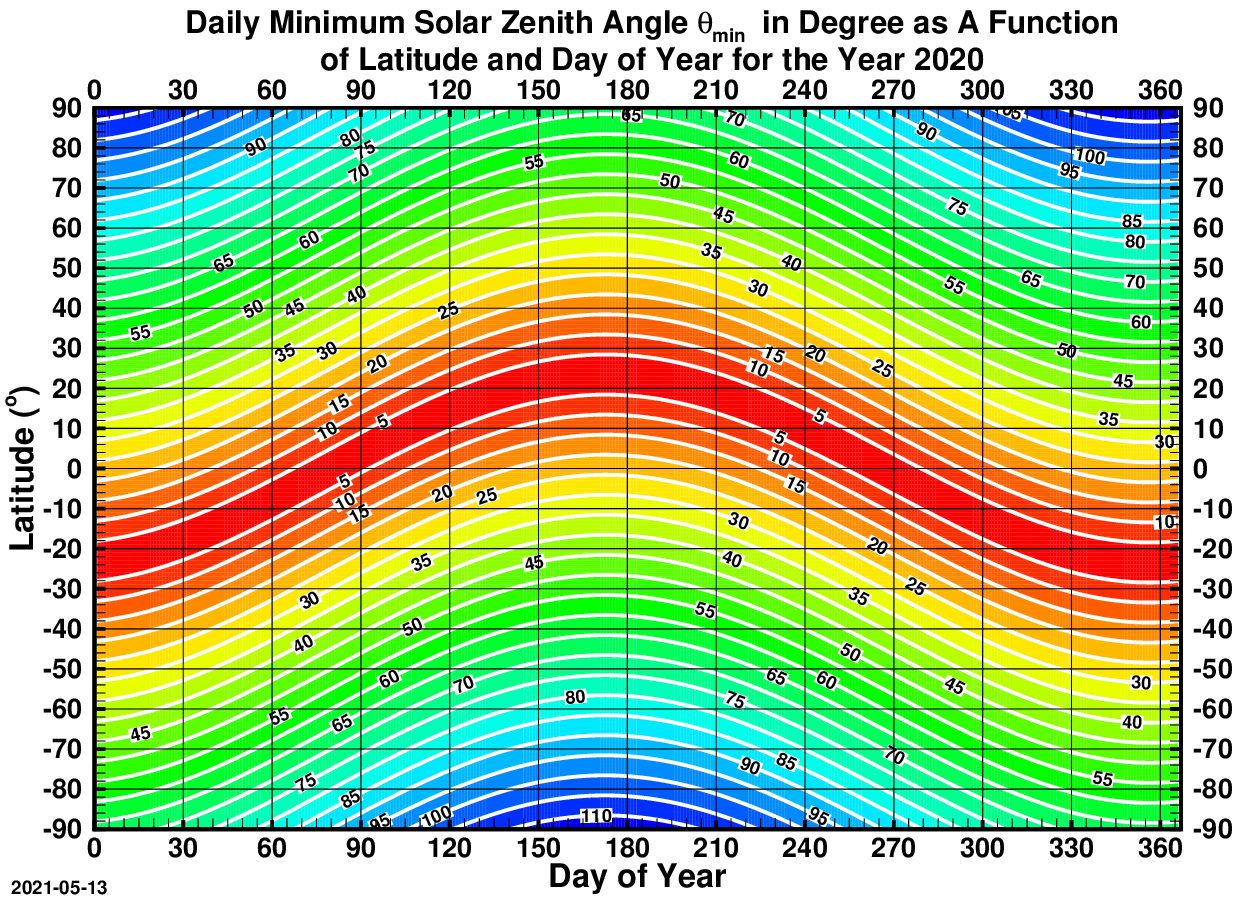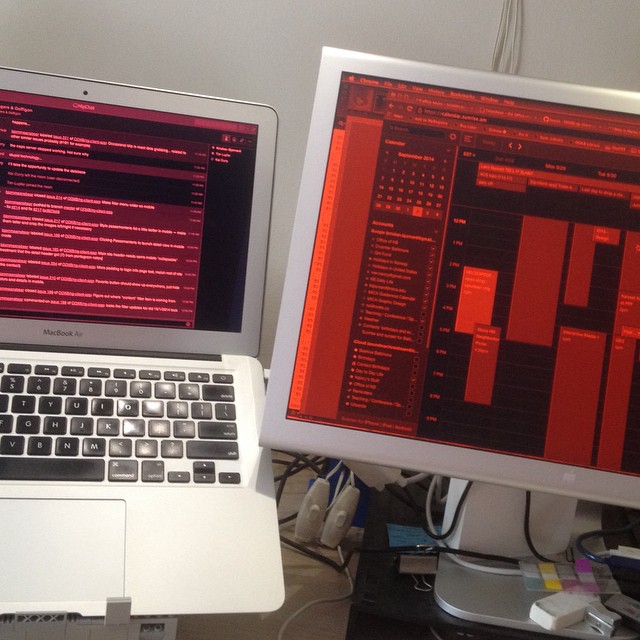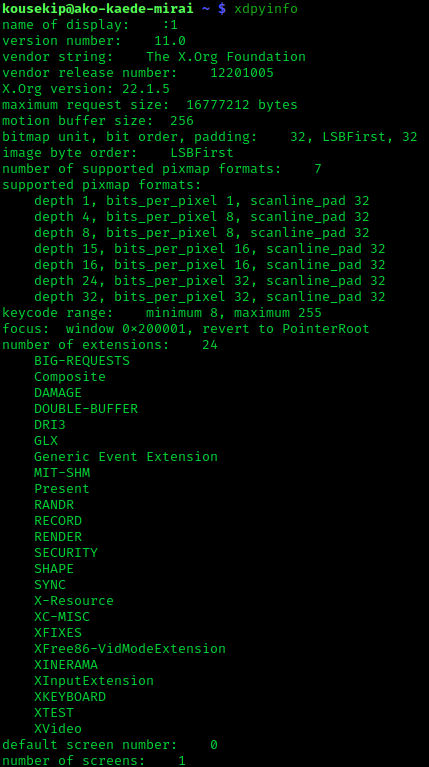|
Redshift (software)
Redshift is an application that adjusts the computer display's color temperature based upon the time of day. The program is free software, and is intended to reduce eye strain as well as insomnia (see Sleep#Circadian clock and Phase response curve#Light). Redshift transitions the computer display's color temperature evenly between daytime and night temperatures to allow the user's eyes to slowly adapt. At night, the color temperature is low and is typically 3000–4000 K, preferably matching the room's lighting temperature. Typical color temperature during the daytime is 5500–6500 K. Features Redshift is primarily distributed for and used on the Linux operating system. Redshift can be used to set a single color temperature and brightness ("one shot mode") or can adjust the temperature and brightness continuously to follow the sun's elevation, in which case it will transition to the night color temperature settings near twilight. The temperature and brightness settings f ... [...More Info...] [...Related Items...] OR: [Wikipedia] [Google] [Baidu] |
Ubuntu MATE
Ubuntu MATE is a free and open-source Linux distribution and an official derivative of Ubuntu. Its main differentiation from Ubuntu is that it uses the MATE desktop environment as its default user interface (based on GNOME 2), instead of the GNOME 3 desktop environment that is the default user interface for Ubuntu. History The Ubuntu MATE project was founded by Martin Wimpress and Alan Pope and began as an unofficial derivative of Ubuntu, using an Ubuntu 14.10 base for its first release; a 14.04 LTS release followed shortly. As of February 2015, Ubuntu MATE gained the official Ubuntu flavour status from Canonical as per the release of 15.04 Beta 1. In addition to IA-32 and x86-64 which were the initial supported platforms, Ubuntu MATE also supports PowerPC and ARMv7 (on the Raspberry Pi 2 and 3 as well as the ODROID XU4). In April 2015, Ubuntu MATE announced a partnership with British computer reseller Entroware, enabling Entroware customers to purchase laptop and desktop compute ... [...More Info...] [...Related Items...] OR: [Wikipedia] [Google] [Baidu] |
Solar Elevation
The solar zenith angle is the zenith angle of the sun, i.e., the angle between the sun’s rays and the vertical direction. It is the complement to the solar altitude or solar elevation, which is the altitude angle or elevation angle between the sun’s rays and a horizontal plane. At solar noon, the zenith angle is at a minimum and is equal to latitude minus solar declination angle. This is the basis by which ancient mariners navigated the oceans. Solar zenith angle is normally used in combination with the solar azimuth angle to determine the position of the Sun as observed from a given location on the surface of the Earth. Formula : \cos \theta_s = \sin \alpha_s = \sin \Phi \sin \delta + \cos \Phi \cos \delta \cos h where * \theta_s is the ''solar zenith angle'' * \alpha_s is the ''solar altitude angle'', \alpha_s = 90° – \theta_s * h is the hour angle, in the local solar time. * \delta is the current declination of the Sun * \Phi is the local lati ... [...More Info...] [...Related Items...] OR: [Wikipedia] [Google] [Baidu] |
Night Shift (software)
Night Shift is a built in software feature of iOS and macOS. It was introduced in 2016-2017 into iOS in iOS 9.3 and into macOS in macOS Sierra 10.12.4. The feature changes the color temperature of the display towards the warmer part of the color spectrum that reduces some of the blue light from the screen. Apple claims that the feature may help users have a better night's sleep by filtering blue wavelengths from the display, which suppress melatonin biosynthesis. The feature is similar to the functionality f.lux provides. Effectiveness Changing the color temperature of the display from blue towards yellow (without dimming the screen) was shown to have no effect on sleep outcomes (sleep latency, duration, efficiency and wake after sleep onset) in a 2021 study on 167 college undergraduates and to be insufficient for preventing the impact on melatonin suppression. In mice, yellow colors disrupted the mouse body clock more than equally bright blue colors. Compatibility The Nigh ... [...More Info...] [...Related Items...] OR: [Wikipedia] [Google] [Baidu] |
Red Moon (software)
Red Moon is a free software application for the Android operating system, designed to filter blue light from the device's display, helping reduce eye strain during night-time use and disruption of sleep patterns. It allows for independent adjustment of colour temperature, luminosity and filter level, making it also possible to lower the effective screen brightness below the usual minimum brightness level of the device. Red Moon does not require root. See also * List of free and open-source Android applications * Redshift (software) *Night Shift (software) *Electronic media and sleep *Light effects on circadian rhythm *Delayed sleep phase disorder References External links Source code* {{F-Droid, com.jmstudios.redmoon, Red Moon Red Moonat Google Play Google Play, also known as the Google Play Store and formerly the Android Market, is a digital distribution service operated and developed by Google. It serves as the official app store for certified devices running on the ... [...More Info...] [...Related Items...] OR: [Wikipedia] [Google] [Baidu] |
Linux Mint
Linux Mint is a community-driven Linux distribution based on Ubuntu (which is in turn based on Debian), bundled with a variety of free and open-source applications. It can provide full out-of-the-box multimedia support for those who choose to include proprietary software such as multimedia codecs. The Linux Mint project was created by Clément Lefèbvre and is actively maintained by the Linux Mint Team and community. History Linux Mint began in 2006 with a beta release, 1.0, code-named 'Ada', based on Kubuntu. Linux Mint 2.0 'Barbara' was the first version to use Ubuntu as its codebase. It had few users until the release of Linux Mint 3.0, 'Cassandra'. Linux Mint 2.0 was based on Ubuntu 6.10, using Ubuntu's package repositories and using it as a codebase. It then followed its own codebase, building each release from the previous one, but continuing to use the package repositories of the latest Ubuntu release. This made the two systems' bases almost identical, guaranteeing f ... [...More Info...] [...Related Items...] OR: [Wikipedia] [Google] [Baidu] |
XFlux
f.lux (pronounced "flux") is a cross-platform computer program that adjusts a display's color temperature according to location and time of day, offering functional respite for the eyes. The program is designed to reduce eye strain during night-time use, helping to reduce disruption of sleep patterns. Functionality On installation, the user can choose a location based on geographic coordinates, a ZIP code, or the name of a location. The program then automatically calibrates the device display's color temperature to account for time of day, based on sunrise and sunset at the chosen location. At sunset, it will gradually change the color temperature to a warmer color and restore the original color at sunrise. f.lux offers a variety of color profiles and pre-defined temperature values, modifying program behaviour for specific programs or activities; including a mode for film watching, decreasing red tinge (for 2.5 hours), and a darkroom mode that does not affect night-adapt ... [...More Info...] [...Related Items...] OR: [Wikipedia] [Google] [Baidu] |
Chmod
In Unix and Unix-like operating systems, is the command (computing), command and system call used to change the File-system permissions, access permissions and the #Special modes, special mode flags (the setuid, ''setuid'', ''setgid'', and sticky bit, ''sticky'' flags) of file system objects (Computer file, files and Directory (computing), directories). Collectively these were originally called its modes, and the name was chosen as an abbreviation of ''change mode''. History A command first appeared in AT&T Corporation, AT&T Unix, UNIX version 1, along with the system call. As systems grew in number and types of users, access-control lists were added to many file systems in addition to these most basic modes to increase flexibility. The version of bundled in GNU coreutils was written by David MacKenzie and Jim Meyering. The command is available as a separate package for Microsoft Windows as part of the UnxUtils collection of Native (computing), native Windows API, Win32 por ... [...More Info...] [...Related Items...] OR: [Wikipedia] [Google] [Baidu] |
Command-line Interface
A command-line interpreter or command-line processor uses a command-line interface (CLI) to receive commands from a user in the form of lines of text. This provides a means of setting parameters for the environment, invoking executables and providing information to them as to what actions they are to perform. In some cases the invocation is conditional based on conditions established by the user or previous executables. Such access was first provided by computer terminals starting in the mid-1960s. This provided an interactive environment not available with punched cards or other input methods. Today, many users rely upon graphical user interfaces and menu-driven interactions. However, some programming and maintenance tasks may not have a graphical user interface and use a command line. Alternatives to the command-line interface include text-based user interface menus (for example, IBM AIX SMIT), keyboard shortcuts, and various desktop metaphors centered on the pointer (usual ... [...More Info...] [...Related Items...] OR: [Wikipedia] [Google] [Baidu] |
Gamma Correction
Gamma correction or gamma is a nonlinear operation used to encode and decode luminance or tristimulus values in video or still image systems. Gamma correction is, in the simplest cases, defined by the following power-law expression: : V_\text = A V_\text^\gamma, where the non-negative real input value V_\text is raised to the power \gamma and multiplied by the constant ''A'' to get the output value V_\text. In the common case of , inputs and outputs are typically in the range 0–1. A gamma value \gamma 1 is called a ''decoding gamma'', and the application of the expansive power-law nonlinearity is called gamma expansion. Explanation Gamma encoding of images is used to optimize the usage of bits when encoding an image, or bandwidth used to transport an image, by taking advantage of the non-linear manner in which humans perceive light and color. The human perception of brightness ( lightness), under common illumination conditions (neither pitch black nor blindingly bright), fol ... [...More Info...] [...Related Items...] OR: [Wikipedia] [Google] [Baidu] |
Direct Rendering Manager
The Direct Rendering Manager (DRM) is a subsystem of the Linux kernel responsible for interfacing with GPUs of modern video cards. DRM exposes an API that user-space programs can use to send commands and data to the GPU and perform operations such as configuring the mode setting of the display. DRM was first developed as the kernel-space component of the X Server Direct Rendering Infrastructure, but since then it has been used by other graphic stack alternatives such as Wayland. User-space programs can use the DRM API to command the GPU to do hardware-accelerated 3D rendering and video decoding, as well as GPGPU computing. Overview The Linux kernel already had an API called fbdev, used to manage the framebuffer of a graphics adapter, but it couldn't be used to handle the needs of modern 3D-accelerated GPU-based video hardware. These devices usually require setting and managing a command queue in their own memory to dispatch commands to the GPU and also require management ... [...More Info...] [...Related Items...] OR: [Wikipedia] [Google] [Baidu] |
RandR
X.Org Server is the free and open-source implementation of the X Window System display server stewarded by the X.Org Foundation. Implementations of the client-side X Window System protocol exist in the form of ''X11 libraries'', which serve as helpful APIs for communicating with the X server. Two such major X libraries exist for X11. The first of these libraries was Xlib, the original C language X11 API, but another C language X library, XCB, was created later in 2001. Other smaller X libraries exist, both as interfaces for Xlib and XCB in other languages, and as smaller standalone X libraries. The services with which the X.Org Foundation supports X Server include the packaging of the releases; certification (for a fee); evaluation of improvements to the code; developing the web site, and handling the distribution of monetary donations. The releases are coded, documented, and packaged by global developers. Software architecture The X.Org Server implements the server side of ... [...More Info...] [...Related Items...] OR: [Wikipedia] [Google] [Baidu] |





